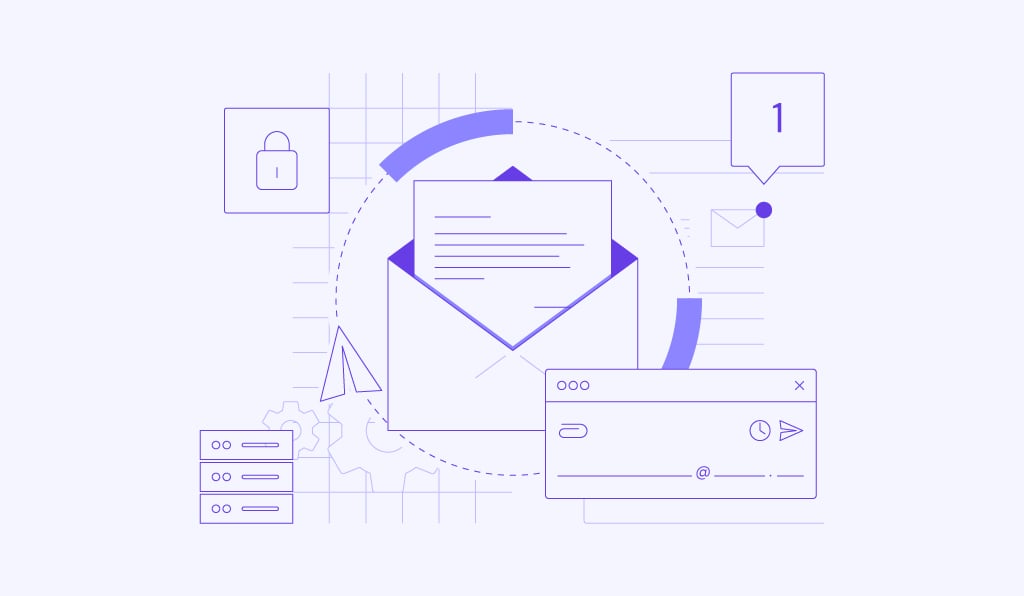How to create a Black Friday ecommerce strategy
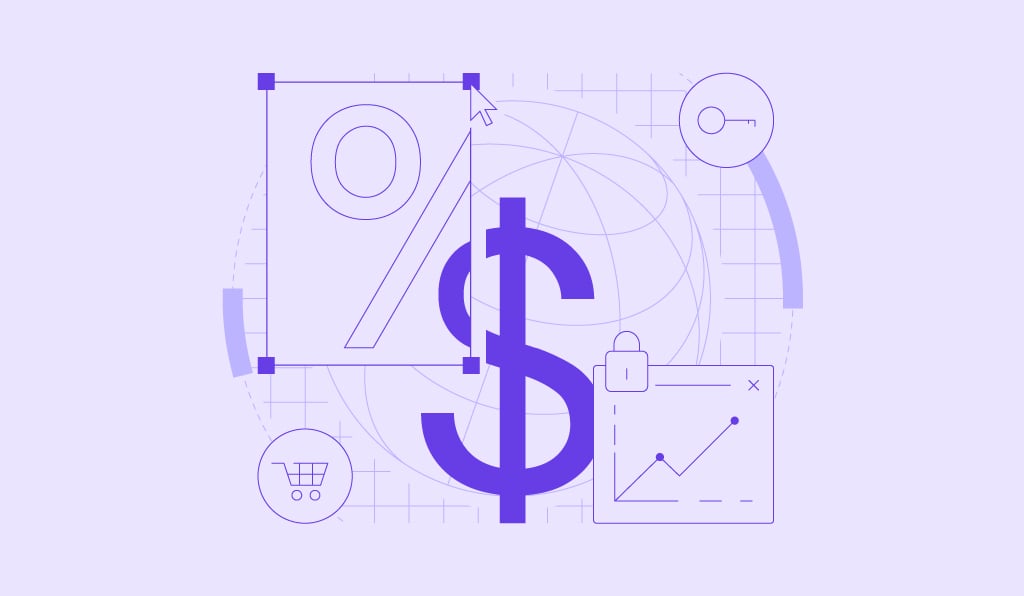
Black Friday has evolved from a post-Thanksgiving tradition into one of the world’s most significant shopping events. As millions of consumers hunt for deals online, businesses need a strong Black Friday ecommerce strategy to stand out from the competition, attract buyers, and maximize revenue.
Here are 12 essential steps to prepare your Black Friday marketing campaign:
1. Plan discount pricing strategies that protect your profit margins. Determine which products to discount and by how much, ensuring promotions drive sales without eroding profitability.
2. Launch your campaign early to build anticipation. Start teasing offers weeks in advance to generate excitement and increase visibility before competitors flood the market.
3. Optimize website performance for peak traffic. Ensure your site loads quickly and can handle surges in visitors without slowing down or crashing during critical shopping hours.
4. Streamline the checkout process. Minimize steps, offer guest checkout options, and remove friction points that lead to abandoned carts.
5. Apply discounts automatically at checkout. Let shoppers see their savings immediately without requiring promo codes to create a smoother purchasing experience.
6. Test every element of the user journey. Verify that navigation, product pages, search functionality, and payment options work flawlessly across all devices.
7. Synchronize inventory across all channels. Connect your physical and online stock management systems to prevent overselling and disappointing customers with out-of-stock items.
8. Create urgency with scarcity signals. Use countdown timers, limited-time offers, and low-stock alerts to motivate shoppers to complete purchases quickly.
9. Set up abandoned cart recovery campaigns. Deploy automated email reminders with incentives to recapture sales from shoppers who left items in their carts.
10. Personalize the shopping experience. Leverage browsing history and purchase data to show relevant product recommendations that resonate with individual customers.
11. Implement strategic upselling and cross-selling. Suggest complementary products and premium alternatives to increase average order value without being pushy.
12. Prepare shipping and fulfillment operations. Scale up logistics, clearly communicate delivery timelines, and ensure you can process and ship orders promptly to meet customer expectations.
What is Black Friday ecommerce?
Black Friday ecommerce refers to the online sales and promotional campaigns businesses run during the Black Friday period. What once centered on crowded physical stores has shifted predominantly to digital channels, with most people now preferring to shop online.
This transformation reflects changing consumer expectations. Today’s shoppers want fast checkout, compelling deals, and the convenience of shopping anytime, anywhere. Businesses that sell online can reach a wider audience, automate tasks, and provide a better customer experience.
A strong Black Friday ecommerce strategy allows you to handle traffic spikes, meet customer expectations, and capitalize on one of the year’s most lucrative shopping events.
What are recent Black Friday ecommerce trends?
Recent Black Friday statistics reveal that around one-third of Americans plan to spend more than last year, with peak shopping activity occurring in the morning hours. While hybrid shopping remains popular, nearly 30% of customers now shop exclusively online, making your digital storefront more important than ever.
Mobile shopping continues to surge among younger shoppers, though desktop still dominates overall traffic. This makes cross-device optimization essential. Buyers also care about prices and perks – three in five shoppers base their purchasing decisions on discounts, and most consider free shipping nonnegotiable. Without it, they’ll abandon their carts for competitors who offer it.
Email marketing remains a powerful sales driver, influencing over half of all purchasing decisions. A well-timed Black Friday email campaign helps you reach customers right when they’re ready to buy. Aligning your Black Friday ecommerce strategy with these trends lets you turn browsing into revenue.
Why Black Friday ecommerce is important for businesses
Black Friday ecommerce isn’t just a sales opportunity. It’s a great time to grow your business, connect with your customers, and stay ahead in a competitive market. Here’s why it matters:
- High sales potential. A well-prepared online store with a compelling Black Friday promotion can attract massive traffic and generate substantial revenue in just days.
- Stronger brand visibility. Black Friday campaigns expand your reach, attracting new email subscribers and social media followers who may convert into customers later.
- Opportunity to attract new customers. Deal-seekers discover your brand during this event. A positive first experience can turn them into repeat buyers.
- Enhanced customer engagement. Limited-time offers, countdowns, and targeted emails create excitement that strengthens your relationship with your audience.
- Higher average order value. Strategic upselling and cross-selling encourage customers to spend more than originally planned.
- Inventory clearance. Clear out older or slow-moving stock with discounts to make room for new products while keeping customers happy with lower prices.
How to prepare a Black Friday ecommerce campaign
Planning a successful Black Friday ecommerce campaign requires more than just slashing prices. The most effective Black Friday marketing strategies combine early preparation, smooth checkout, and strategic use of email and automation tools.
If you’re wondering how to prepare for Black Friday ecommerce, these Black Friday tips will help you drive sales and build lasting customer relationships, whether you’re launching your first campaign or refining your approach.
1. Plan your Black Friday deals
Discounts are powerful Black Friday motivators, but poorly planned promotions can erode profit margins. The key is balancing compelling offers with profitability to maximize Black Friday ecommerce sales.
Start by analyzing your product performance. Identify best-sellers, seasonal items, or overstocked inventory that can handle markdowns. Then, choose the discount type that best fits your goals:
- Percentage discounts (like “30% off selected items”) drive bulk purchases.
- Bundle deals (such as “buy one, get one 50% off”) increase average order value.
- Tiered discounts (like “spend $50, get 10% off; spend $100, get 20% off”) encourage higher spending.
Most Black Friday discounts range from 20-40%, depending on product margins. High-margin or digital products can sustain discounts of 50% or more, while lower-margin items work better with smaller discounts paired with free shipping or bundles.
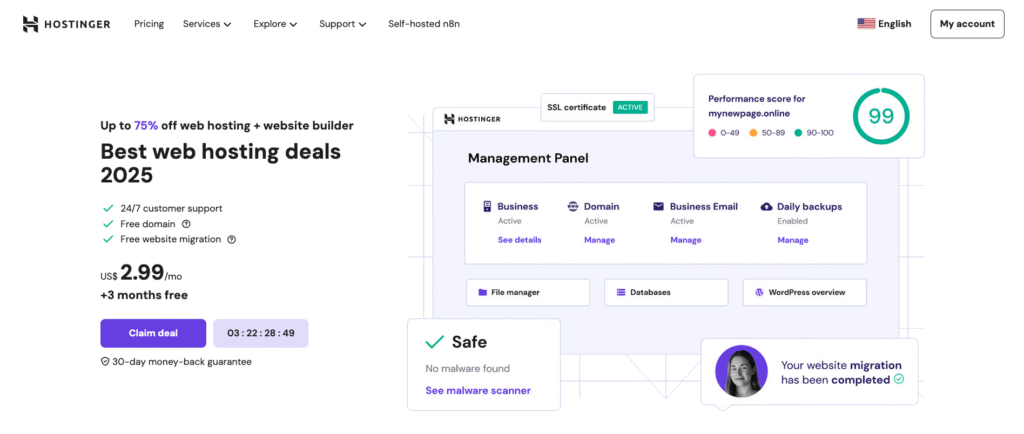
Don’t hesitate to combine multiple offer types. Hostinger, for example, offers up to 75% off web hosting and website builder plans during Black Friday. Annual plans also include three free months and free domain registration, giving shoppers extra motivation to commit.
2. Launch the campaign early
The best time to launch your Black Friday campaign is 1-2 weeks before the event, though it’s common to roll out sneak peeks a month in advance. Early launches build anticipation, give buyers time to plan their purchases, and put your brand in front of customers before their inboxes and feeds get flooded with competing offers.
Use multiple channels to warm up your audience. Strategically timing your email marketing for Black Friday can re-engage past customers and generate early momentum. Meanwhile, a consistent social media campaign increases visibility, encourages sharing, and drives traffic to your site.
Update your website with banners, pop-ups, or countdown timers to let visitors know something big is coming. The goal is to stay top of mind so customers buy from you the moment Black Friday arrives.
3. Audit your website’s performance
Before the Black Friday rush begins, make sure your website can handle a surge in visitors. A slow or unresponsive site drives potential buyers away, increases bounce rates, and damages your reputation, especially during a high-stakes sales event like Black Friday.
Start by running a full audit of your website’s performance. Check your page load speed, mobile responsiveness, server uptime, and overall user experience. If you’re unsure where to start, see our guide on using GTmetrix for website testing.
Once you’ve identified bottlenecks, optimize your website by compressing images, reducing unnecessary scripts, enabling browser caching, and implementing a content delivery network (CDN). If you’re using WordPress or an ecommerce platform, make sure all themes and plugins are up to date.
Consider upgrading to a more reliable hosting provider with better speed, uptime, and scalability. Hostinger’s cloud hosting services, for example, handle high traffic volumes while maintaining 99.9% uptime.
Did you know?
According to website load time statistics, bounce rates increase by 32% when pages take three seconds to load. At five seconds, that number jumps to 90%. Fast-loading pages are essential to keeping shoppers engaged and preventing lost sales.

4. Optimize the checkout process
A clunky checkout experience can lead to lost sales even when your products and prices are compelling. Optimize your checkout process to reduce cart abandonment, build trust, and improve your conversion rates.
Follow these five best practices for a smoother checkout:
- Keep it simple. Use a clean layout and minimize required form fields.
- Enable guest checkout. Let customers purchase without creating an account.
- Display total costs upfront. Show shipping fees, taxes, and discounts early to avoid surprises at checkout.
- Offer multiple payment options. Support various payment methods – from credit cards to digital wallets – to cater to different customer preferences.
- Optimize for mobile. Ensure the entire checkout process works smoothly on smartphones and tablets. This includes responsive design, easy-to-tap buttons, and autofill support.
5. Automate Black Friday discount applications
Manually entering discount codes can slow down the checkout process and frustrate customers. During Black Friday, when every second counts, this friction can cost you sales.
Automatically applying discounts at checkout eliminates this barrier, builds trust, and improves the user experience. When customers see savings reflected immediately, they’re more likely to complete their purchase.
Nike executes this effectively. The sportswear brand automatically applies Black Friday discounts when customers add products to their carts. Shoppers see the final price instantly ‒ no need to enter a code.
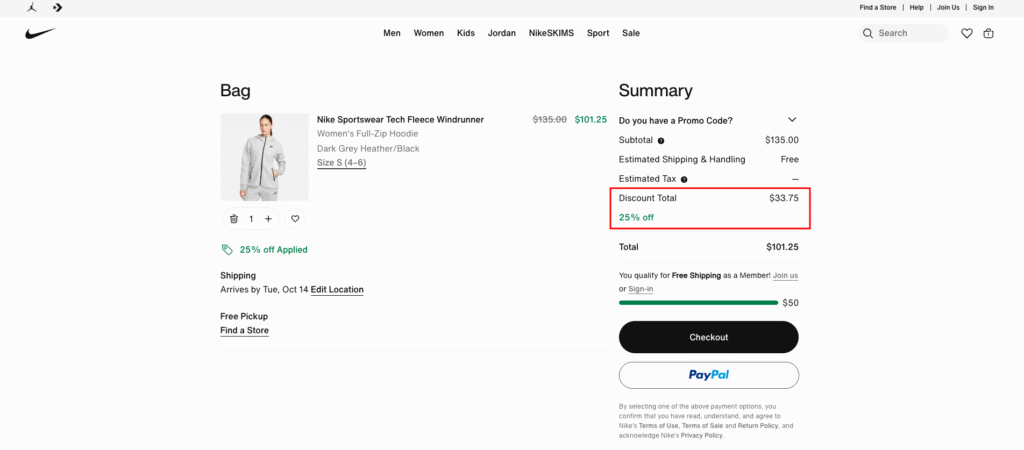
6. Test your website
People come to your website to browse and make purchases, so it’s crucial to keep it running smoothly at all times. Even minor glitches can disrupt the shopping experience, damaging your brand’s credibility and revenue during peak traffic periods.
Test these critical elements across your entire user journey:
- Navigation. Verify that menus, product categories, and search bars function properly. Customers should be able to find what they’re looking for within a few clicks.
- Product pages. Confirm that product images load quickly, descriptions are accurate, and stock levels display correctly. Complete information enables customers to make confident decisions.
- Add-to-cart and checkout. Test these functions on desktop and mobile. Buttons should respond instantly, and the cart should update seamlessly without errors.
- Forms and autofill. Ensure shipping, billing, and payment forms are easy to fill out and support autofill functionality.
- Promo codes and discount logic. Verify that automatic discounts apply correctly under all conditions.. Double-check exclusions and stacking rules.
- Mobile experience. Test your entire site on different devices and screen sizes for a consistent browsing experience.
7. Ensure inventory accuracy
Selling products that aren’t in stock is one of the quickest ways to lose customer trust during Black Friday. When your physical inventory and website listings don’t match, you risk overselling, order cancellations, and disappointed customers, all of which can damage your reputation and hurt future sales.
Make sure your inventory syncs in real time across all sales channels. Use inventory management software that updates stock levels automatically as orders come in. If you sell both online and in-store, integrate your systems to maintain accurate quantities everywhere.
Audit your stock before the campaign launches. Check for discrepancies, confirm product availability, and remove or flag items with limited stock. For high-demand products, consider setting purchase limits to prevent overselling and distribute stock across more customers.
If something sells out, mark it as “out of stock” immediately and offer alternatives when possible. This transparency maintains trust even when items are unavailable.
WordPress user?
Check out our list of the top eight WooCommerce inventory management plugins to organize your online store.
8. Create a sense of urgency
Black Friday is all about fast decisions and limited-time offers, so your messaging should reflect that pressure. Creating a sense of urgency encourages buyers to act quickly rather than waiting or comparing options. This increases conversions, especially when customers know the deals won’t last.
Use these time-sensitive elements to motivate quick purchases:
- Countdown timers. Display real-time countdowns showing exactly how long deals remain available.
- Low stock alerts. Show remaining inventory quantities to encourage faster decision-making.
- Flash sale banners. Highlight short-term promotions with eye-catching banners like “Ends in 1 hour” or “Today only.”
- Urgent call-to-action (CTA) buttons. Use action-driven language like “Shop now,” “Last chance,” or “Claim your deal” to move customers toward checkout.
- Pop-ups and exit-intent messages. Trigger special offers when a user is about to leave, giving limited-time incentives like additional discounts or free shipping.
9. Prepare an abandoned cart recovery campaign
Even compelling Black Friday offers don’t prevent cart abandonment. A strategic recovery campaign can recapture lost sales through two primary tactics: follow-up emails and exit-intent pop-ups.
Send email reminders within hours of abandonment to gently nudge customers back to their carts. Sweetening the offer with a small discount or free shipping often closes the deal.
Exit-intent pop-ups work in real time, triggering when users attempt to close the tab or navigate away. Nike uses this tactic to remind shoppers of their cart contents just as they’re about to leave.
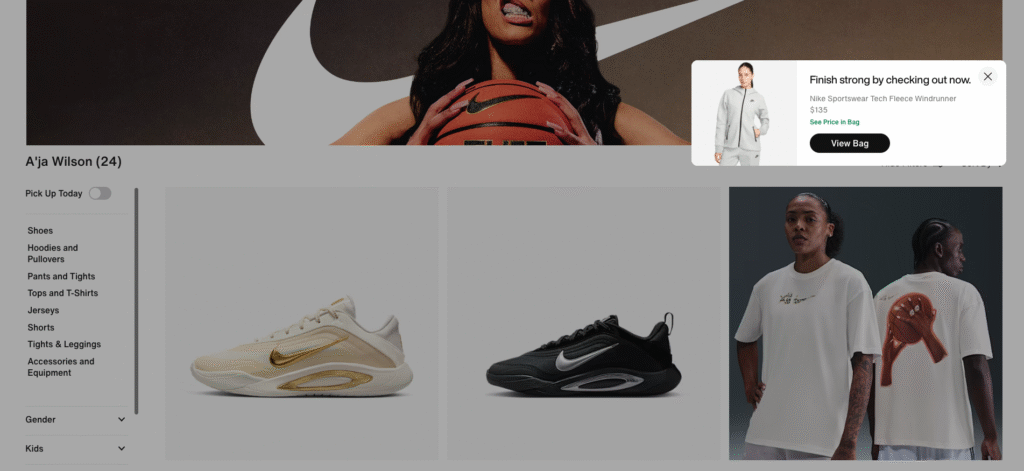
If you’re a WooCommerce user, automate your recovery efforts with WooCommerce abandoned cart recovery plugins. These tools send personalized reminders and track recovery performance without manual intervention.
10. Provide a personalized shopping experience
When customers see relevant products or offers tailored to their needs, they stay longer and buy more. Personalization demonstrates that your store understands their needs, building trust and increasing conversions.
Customize the user journey through product recommendations based on browsing behavior and targeted newsletter emails that reflect past purchases or cart activity. Even small touches, such as using the customer’s name in an email or greeting returning users with special offers, help create a more engaging shopping experience.
Enhance your Black Friday campaign with these personalization tactics:
- User-specific landing pages. Customize pages by traffic source, location, or shopping behavior to personalize the experience from the first click.
- Personalized countdown emails. Remind customers how much time they have left to claim deals or complete cart purchases.
- Audience segmentation. Group users into categories like “first-time buyer,” “loyal customer,” or “deal seeker” for targeted promotions.
- Behavioral pop-ups. Trigger messages based on browsing patterns, such as suggesting related products when customers linger on specific pages.
- Mobile alerts. Send push notifications with special offers or restock updates for items they’ve viewed or wishlisted.
11. Leverage upselling and cross-selling
Black Friday brings an opportunity to increase average order value through two proven tactics: upselling and cross-selling.
Upselling involves suggesting premium or upgraded versions of the product a customer is considering. This method is most effective when upgrades provide clear additional value, such as enhanced features, increased capacity, or improved durability. Upselling is particularly effective for digital products and services.
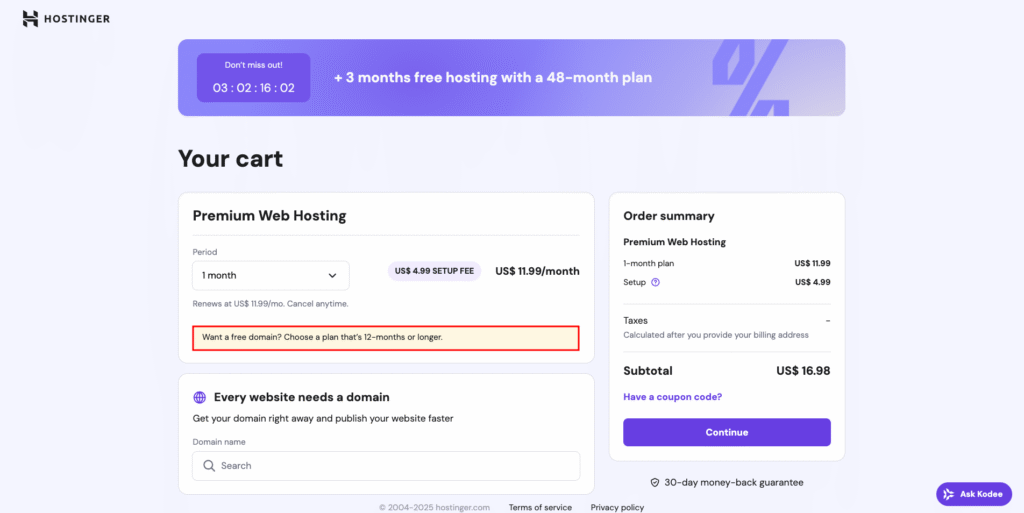
Cross-selling is about recommending complementary products. Think “frequently bought together” or “complete the set.” Display these suggestions on product pages, in the cart, or during checkout. Limit recommendations to three related items to avoid overwhelming shoppers.
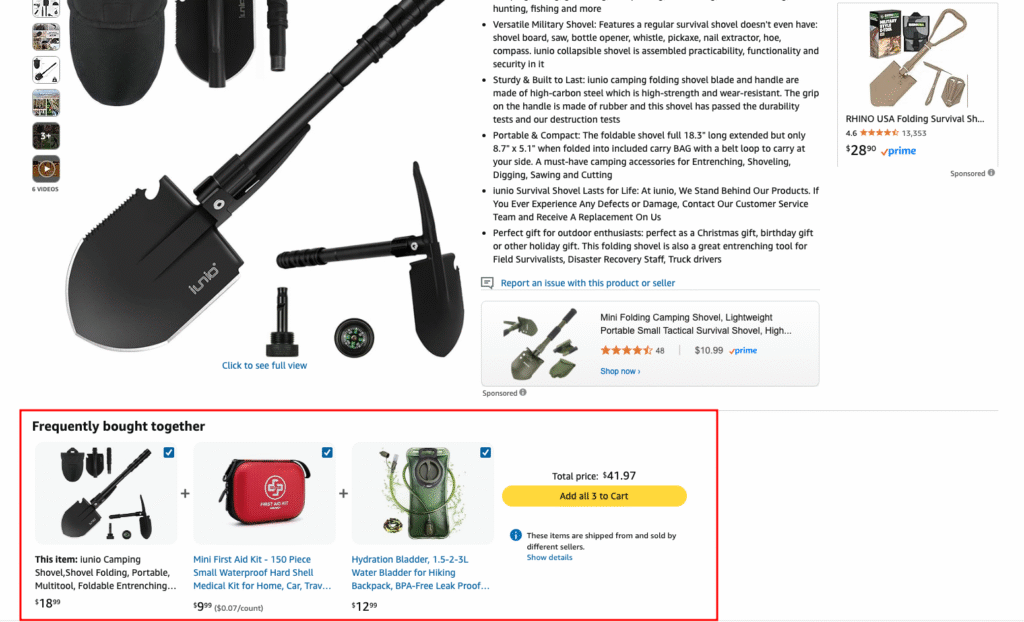
Focus on relevance, timing, and clear value to make both tactics work for your Black Friday campaign. When done right, these strategies enhance the shopping experience and boost sales without feeling pushy.
12. Prepare a shipping and order fulfillment process
A smooth delivery experience is as critical as seamless checkout. When customers expect fast service and clear communication, shipping delays or fulfillment issues can lead to disappointment and a loss of trust.
Optimize your shipping and fulfillment with these strategies:
- Stock up early. Prevent backorders and fulfillment delays by securing inventory well in advance of Black Friday.
- Verify carrier capacity. Confirm delivery times and potential delays with carriers ahead of peak season.
- Offer multiple shipping options. Provide a range of delivery options, from standard to express, to meet diverse customer needs.
- Display estimated delivery dates. Show delivery timelines on product pages and at checkout to manage expectations and reduce support inquiries.
- Streamline packaging and labeling. Utilize automation tools whenever possible to expedite fulfillment and minimize errors.
- Establish a clear return policy. Make returns straightforward and transparent to build post-purchase trust.
What is the difference between Black Friday and Cyber Monday?
Black Friday and Cyber Monday are both major shopping events, but they focus on different channels and customer behavior.
Black Friday takes place the day after Thanksgiving and features both in-store and online sales across various categories, including electronics, clothing, and home goods.
Cyber Monday follows the next Monday and focuses exclusively on online deals, typically highlighting tech products, digital services, and ecommerce-specific promotions.
You can take advantage of both events by treating them as a unified sales strategy rather than separate campaigns. Start strong with your Black Friday offers to capture early interest, then follow up with exclusive Cyber Monday deals to maintain momentum.
Use the second phase to refresh discounts, feature different products, or target specific customer segments. Email reminders, retargeting ads, and countdown timers can re-engage visitors who browsed but didn’t buy during Black Friday.
This integrated approach maximizes your exposure and drives sales throughout the entire weekend.
What are examples of Black Friday ecommerce campaigns?
Examining successful Black Friday campaigns, particularly their landing pages, reveals practical strategies for driving conversions. These pages serve as central hubs for offers, countdowns, and calls to action, making them critical to ecommerce success.
One strong Black Friday landing page example comes from BIKE24. It features a bold “Black Friday Week” headline, daily deal stickers, and a countdown timer that creates urgency and encourages quick action.
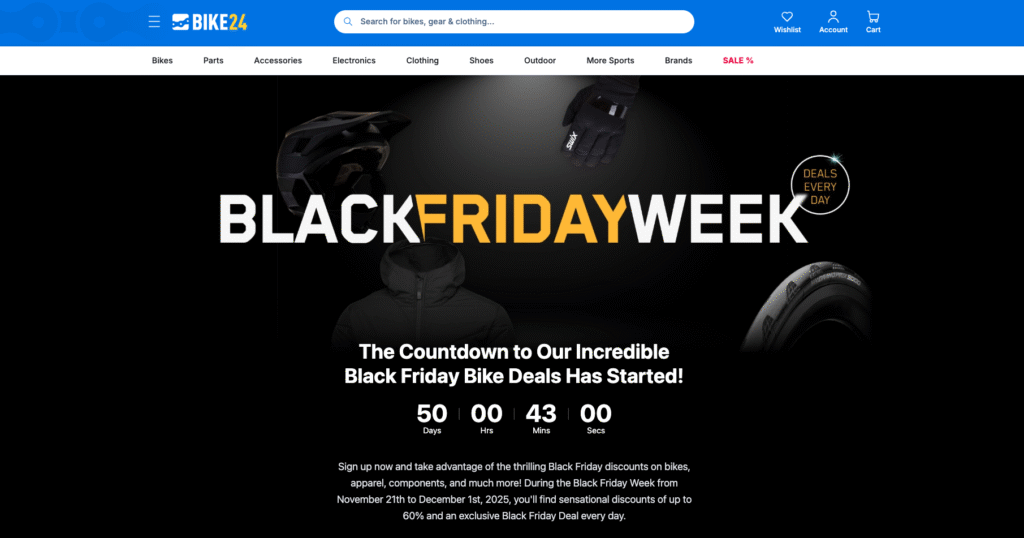
Samsung takes a strategic approach by keeping its Black Friday page live year-round. They optimize it for SEO while using it as a lead capture tool even during off-season periods.
Meanwhile, Brooks Brothers combines a compelling hero section with an on-page FAQ that addresses common buyer concerns, helping shoppers move confidently toward checkout.
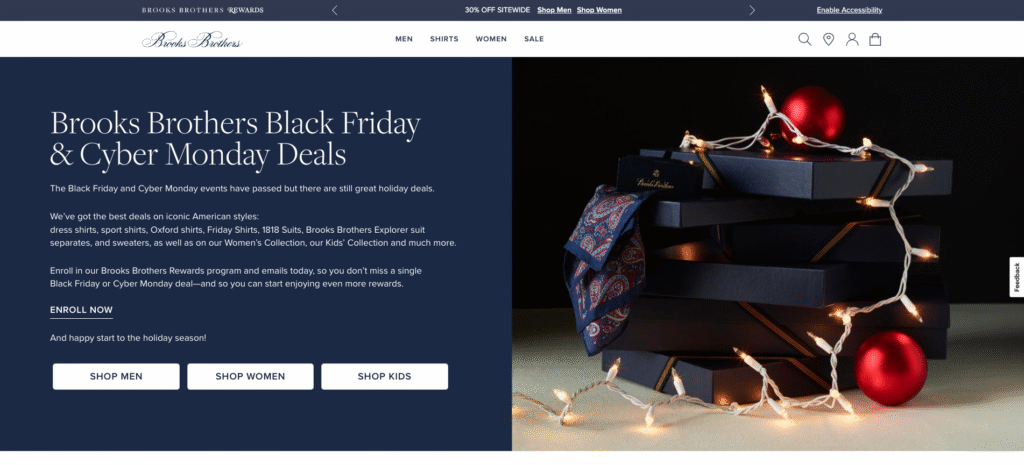
Each of these campaigns demonstrates how thoughtful design, clear messaging, and strategic timing turn Black Friday traffic into real sales.
What will your Black Friday campaign look like?
All of the tutorial content on this website is subject to Hostinger's rigorous editorial standards and values.



